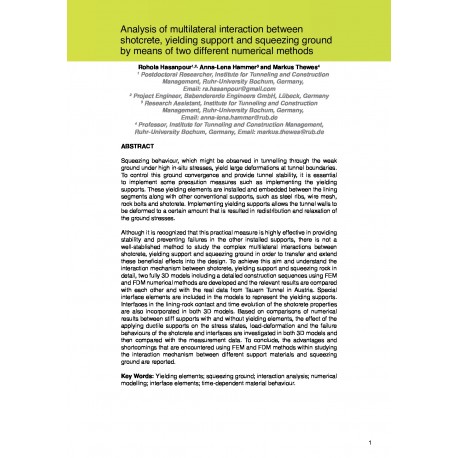Cart
0
0
No document
0,00 €
Total
Document successfully added to your shopping cart
Quantity
Total
There are 0 items in your cart.
There is 1 item in your cart.
Total documents
Total shipping
To be determined
Total
Search & filter
Search for a publication
Search & filter

Analysis of multilateral interaction between shotcrete, yielding support and squeezing ground by means of two different numerical methods
3616_analysis_of_multilateral_in
R. Hasanpour / M. Thewes / A.-L. Hammer
Squeezing behaviour, which might be observed in tunnelling through the weak ground under high in-situ stresses, yield large deformations at tunnel boundaries. To control this ground convergence and provide tunnel stability, it is essential to implement some precaution measures such as implementing the yielding supports. These yielding elements are installed and embedded between the lining segments along with other conventional supports, such as steel ribs, wire mesh, rock bolts and shotcrete. Implementing yielding supports allows the tunnel walls to be deformed to a certain amount that is resulted in redistribution and relaxation of the ground stresses. Although it is recognized that this practical measure is highly effective in providing stability and preventing failures in the other installed supports, there is not a well-stablished method to study the complex multilateral interactions between shotcrete, yielding support and squeezing ground in order to transfer and extend these beneficial effects into the design. To achieve this aim and understand the interaction mechanism between shotcrete, yielding support and squeezing rock in detail, two fully 3D models including a detailed construction sequences using FEM and FDM numerical methods are developed and the relevant results are compared with each other and with the real data from Tauern Tunnel in Austria. Special interface elements are included in the models to represent the yielding supports. Interfaces in the lining-rock contact and time evolution of the shotcrete properties are also incorporated in both 3D models. Based on comparisons of numerical results between stiff supports with and without yielding elements, the effect of the applying ductile supports on the stress states, load-deformation and the failure behaviours of the shotcrete and interfaces are investigated in both 3D models and then compared with the measurement data. To conclude, the advantages and shortcomings that are encountered using FEM and FDM methods within studying the interaction mechanism between different support materials and squeezing ground are reported.Yielding elements; squeezing ground; interaction analysis; numerical modelling; interface elements; time-dependent material behaviour.


